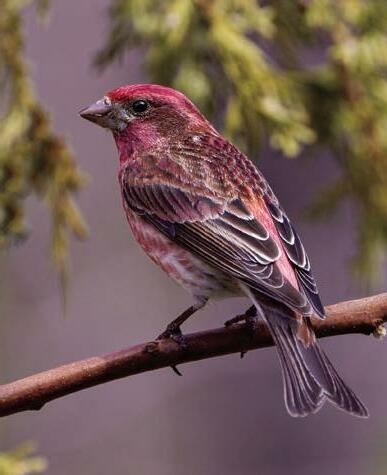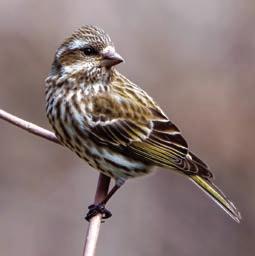
2 minute read
Birdwatch By Susan Campbell
An Uncommon Visitor
The feisty purple finch is in the hood
Advertisement
By susAn CAmpBell
If you happen to
be maintaining a bird feeding station over the next few months, you will want to be on the lookout for an uncommon winter visitor: the purple finch. These feisty little birds are common to our north but some years, when their numbers surge as a result of above average reproductive success, they head further to the south following the breeding season.
It seems that spruce budworms were abundant in boreal forests in June and July, and this resulted in a bumper crop of baby finches. Like most of our songbirds, nestling purple finches require lots of caterpillars to grow into strong fledglings. The family groups merged into wintering flocks sometime in the last couple of months and are working their way southward, as they always do. Given their numbers, purple finches will spread much farther throughout the eastern half of the United States than they normally would. They’ve already been spotted in forests and at feeders in North Carolina.
Purple finches are robust birds that are larger than the chickadees and titmice, which they often associate with during the cooler months. They appear most similar to our ever-present house finches. Male purple finches are not really “purple” as their name would imply. They are more of a raspberry color. In addition to their coloring, they have a distinct whitish eye stripe and heavier bills than their cousins. Females and immature males that lack color can be overlooked as just another little brown bird at your feeder. But note that they are more aggressive and have that distinctive eyebrow. As so many of our winter feeder visitors do, purple finches love black oil sunflower. But they also will come to nyjer, or “thistle seed.” They, like goldfinches, find this tiny but highly fatty seed irresistible.
Away from feeders, purple finches feed on the seeds from conifers to tulip poplar, maple seeds to ragweed, and even dandelions. They may mix in with local house finches at feeding stations or simply with wintering sparrows in brushy habitat. These birds crush seeds and fruits using their powerful bills and strong tongues. The nut inside is consumed completely; therefore, purple finches are considered to be predatory and not dispersal agents, as many birds are.
You may notice a flock as a result of the males chorusing at the tops of trees. Purple finch song is distinguished by a fast rising and falling series of up to two dozen notes. Interestingly, males may incorporate bits of songs sung by other species where they breed. It is not that rare to hear American goldfinch or rufous-sided towhee notes mixed in.
If purple finches learn to efficiently find food as well as avoid predators, they can live a relatively long time for a small bird. The oldest known individual was documented as living over eight and a half years. It was a banded bird — recaptured right here in North Carolina. PS
Susan Campbell would love to receive your wildlife sightings and photographs at susan@ncaves.com.











